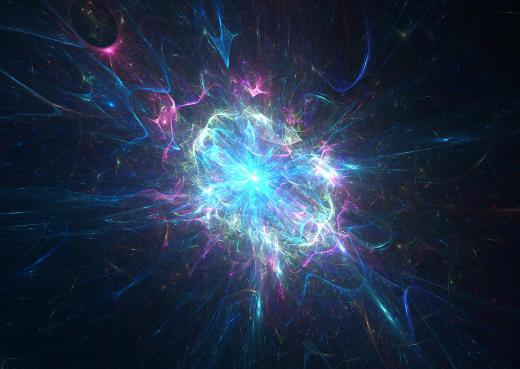What is a Neutron Star?
 Michael Anissimov
Michael Anissimov
A neutron star is a stellar remnant--a super-compressed object left over when stars with a mass between 1.4 and about 3 times the mass of our Sun exhaust their nuclear fuel and collapse inwards. The result is a condensed sphere of matter about 20 km (12 miles) across, with a gravitational field approximately 2 x 10^11 times stronger than that of Earth's.
The density of a neutron star is so great that the protons and electrons making up the atoms fuse to form electrically neutral neutrons, the primary particles making up the neutron star. Because they are electrically neutral, such particles can be packed very closely together, resulting in a celestial object with similar density to that of the atomic nucleus.

The neutron star is an exotic astronomical object whose existence was predicted by theory 35 years before one was actually discovered in 1968. The escape velocity for a neutron star is approximately half the speed of light. The tallest "mountains" on such a star measure in the millimeters (fractions of an inch) rather than kilometers (feet). Because the rotation speed of the star accelerates as it collapses, tremendous rates of angular velocity may be achieved, on the order of 30,000 km/sec (18,640 mi/sec), or one rotation every millisecond or two. When these rapidly rotating stars emit electromagnetic radiation that can be detected on Earth, they are received in continuous pulses, prompting the title "pulsar."
Formed from the core of expired suns, the neutron star is home to exotic forms of matter found nowhere else in the universe: Nuclei composed of huge amounts of neutrons with no orbiting electrons, free neutrons floating in a superdense "neutronium" soup, and possibly exotic forms of matter such as pions or kaons. These are particles composed of unusual configurations or types of quarks, the constituents of subatomic particles. Because conventional atomic forms of matter would be ripped to shreds by the immense gravity and pressure of a neutron star, we may never be able to perform experiments or observations on such objects directly. The primary types of neutron stars include the x-ray burster , pulsar, and magnetar.
AS FEATURED ON:
AS FEATURED ON:











Discussion Comments
Perhaps neutron stars are made up of elements heavier than anything currently known to man -- elements with strange new properties. Why is it assumed that little or nothing exists between the current periodic table of elements and a neutron star.
One has to admit that the jump between the nucleus of a heavy element and the neutron star as a nucleus is pretty huge. Regardless what they are made of, the universe wastes nothing. These remnants doubtless become the seeds of massive stars. It would be nice to study one before it does.
@Elama: How do astronomers actually measure the size of a neutron star? Is it calculated based on the theory of it's makeup or is it a visual measurement of some sort? Can anyone explain for me why neutron stars aren't simply very hot,rapidly rotating, masses of your typical heavier and/or radioactive elements(iron through uranium)? Surely that kind of fusion would take place prior to ending up with a solid neutron star. Anyone care to tackle that question?
I'm under 18 and I know a lot about this stuff, but I was wondering what exactly is time itself? Can we visit the past?
What is dark matter & dark energy?
I want to know about a Red dwarf, please.
How does a neutron star emit electro-magnetic radiation if it is electrically neutral, the definition of a neutron star's components? -David
Much of the time, neutron stars are pulsars, so if we find many rapid pulses of energy from a single point in the sky, we can safely say it is a pulsar, and therefore a neutron star. As to neutron stars that are not pulsars, my only guess would be that they would see large stars orbiting around a point in space where there seems to be nothing at all, but they are not orbiting at a rate fast enough to be orbiting black holes.
It is detected by X-ray
This article is actually more accurate then Wiki-because they have other people help edit the page, everyone..so it doesn't help at all. I suggest that everyone should forget wiki and move on. They don't have reliable information. All of it makes me nervous.
also fyi a teaspoon of a neutron stars matter would weigh 1 billion tons. ron goodrich deadwood south dakota
I like the article. It's a lot simpler than wikipedia, but have a question: how do people detect neutron stars- or at least tell them apart from white dwarfs?
Post your comments